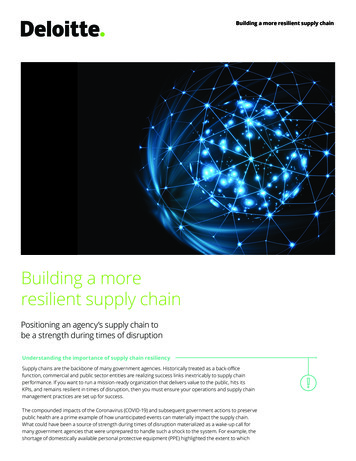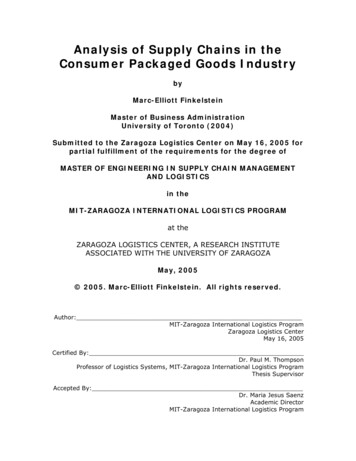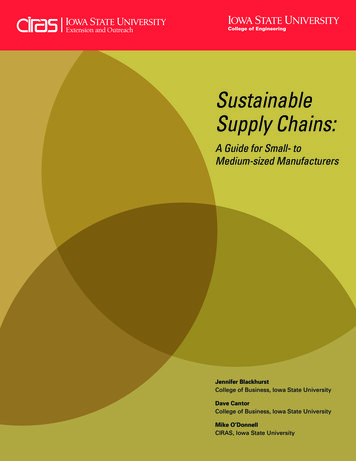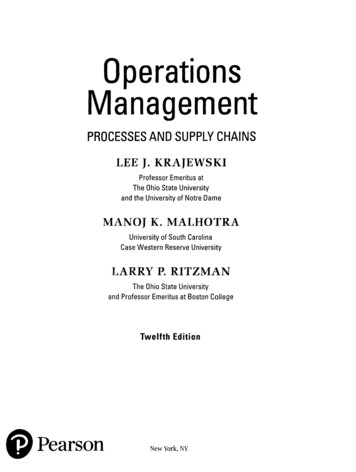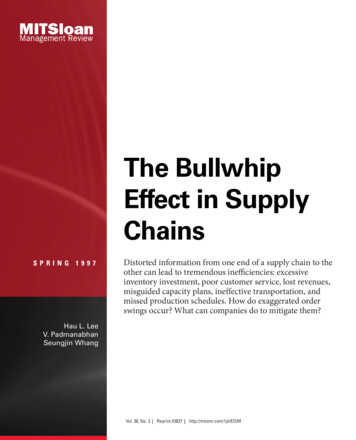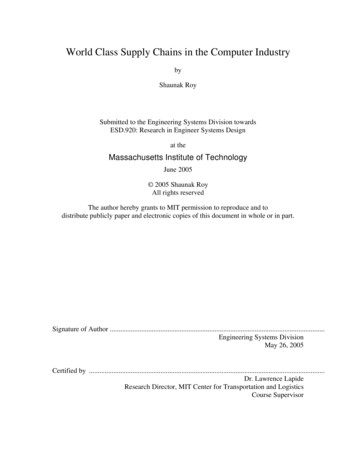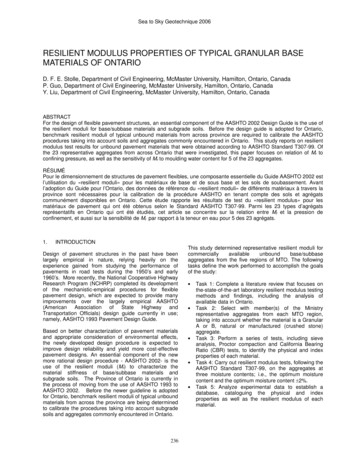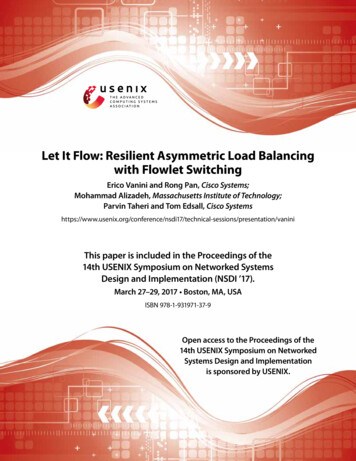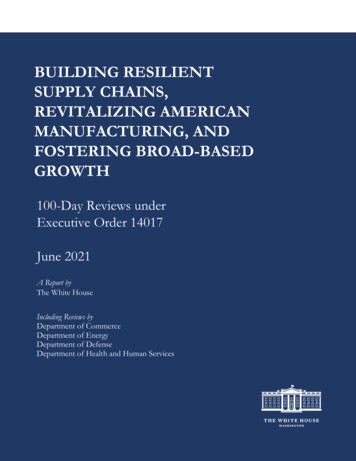
Transcription
BUILDING RESILIENTSUPPLY CHAINS,REVITALIZING AMERICANMANUFACTURING, ANDFOSTERING BROAD-BASEDGROWTH100-Day Reviews underExecutive Order 14017June 2021A Report byThe White HouseIncluding Reviews byDepartment of CommerceDepartment of EnergyDepartment of DefenseDepartment of Health and Human Services
BUILDING RESILIENT SUPPLY CHAINS,REVITALIZING AMERICAN MANUFACTURING,AND FOSTERING BROAD-BASED GROWTHJune 20212
TABLE OF CONTENTSINTRODUCTORY NOTE . 4EXECUTIVE SUMMARY FOR E.O. 14017 100-DAY REVIEWS . 6RECOMMENDATIONS . 12REVIEW OF SEMICONDUCTOR MANUFACTURING AND ADVANCED PACKAGING - DEPARTMENTOF COMMERCE . 21EXECUTIVE SUMMARY . 22INTRODUCTION . 24MAPPING THE SUPPLY CHAIN . 26RISK ASSESSMENT . 53GLOBAL FOOTPRINT . 60OPPORTUNITIES & CHALLENGES . 66RECOMMENDATIONS . 74ABBREVIATIONS . 81REVIEW OF LARGE CAPACITY BATTERIES - DEPARTMENT OF ENERGY. 85EXECUTIVE SUMMARY . 86INTRODUCTION . 89MAPPING OF THE SUPPLY CHAIN. 93RISK ASSESSMENT . 119GLOBAL FOOTPRINT . 123OPPORTUNITIES & CHALLENGES . 129RECOMMENDATIONS . 134ABBREVIATIONS . 148REVIEW OF CRITICAL MINERALS AND MATERIALS - DEPARTMENT OF DEFENSE . 151EXECUTIVE SUMMARY . 152INTRODUCTION . 153MAPPING THE SUPPLY CHAIN . 155GLOBAL FOOTPRINT . 162RISK ASSESSMENT . 175RECOMMENDATIONS . 194ABBREVIATIONS . 204REVIEW OF PHARMACEUTIALS AND ACTIVE PHARMACEUTICAL INGREDIENTS - DEPARTMENT OFHEALTH AND HUMAN SERVICES . 207EXECUTIVE SUMMARY . 208INTRODUCTION . 210MAPPING OF THE SUPPLY CHAIN. 212RISK ASSESSMENT . 217GLOBAL FOOTPRINT . 233OPPORTUNITIES & CHALLENGES . 235RECOMMENDATIONS . 240ABBREVIATIONS. 2503
INTRODUCTORY NOTEFROM NATIONAL ECONOMIC COUNCIL DIRECTOR BRIAN DEESE ANDNATIONAL SECURITY ADVISOR JAKE SULLIVAN TO THE PRESIDENTMr. President:It is our privilege to transmit to you the first set of reports that your Administration has developed pursuantto Executive Order 14017, “America’s Supply Chains.” The enclosed reports assess supply chainvulnerabilities across four key products that you directed your Administration to review within 100 days:semiconductor manufacturing and advanced packaging; large capacity batteries, like those for electric vehicles;critical minerals and materials; and pharmaceuticals and advanced pharmaceutical ingredients (APIs).The enclosed reports are the work of a task force that we convened across more than a dozen departmentsand agencies, consultations with hundreds of stakeholders, public comments submitted by industry andexperts, and deep analytic research by experts from across the government. We would like to particularlythank the four agencies that took the lead in authoring each of the enclosed reports: the Department ofCommerce on semiconductor manufacturing and advanced packaging; the Department of Energy on largecapacity batteries; the Department of Defense on critical materials and minerals; and the Department ofHealth and Human Services, particularly the Food and Drug Administration, on pharmaceuticals and APIs.This work has complemented other work your Administration has undertaken to strengthen U.S. supplychains, including the work to dramatically expand the supply of COVID-19 vaccines and other productsessential to American’s health.Departments and Agencies across your Administration have already begun to implement the reports’recommendations. These include steps to strengthen U.S. manufacturing capacity for critical goods, torecruit and train workers to make critical products here at home, to invest in research and development thatwill reduce supply chain vulnerabilities, and to work with America’s allies and partners to strengthen collectivesupply chain resilience. Both the public and private sector play critical roles in strengthening supply chains,and your Administration will continue to work with industry, labor, and others to make America’s supplychains stronger.We have already launched the second phase of the supply chain initiative you directed in E.O. 14017, whichreviews six critical industrial base sectors that underpin America’s economic and national security: the defenseindustrial base, public health and biological preparedness industrial base, information and communicationstechnology industrial base, energy sector industrial base, transportation industrial base, and supply chains forproduction of agricultural commodities and food products. We will report back to you on those sectors byFebruary 24, 2022, the one-year mark of your signing E.O. 14017.4
The 100-day reports make clear: more secure and resilient supply chains are essential to our national security,our economic security, and our technological leadership. The work of strengthening America’s critical supplychains will require sustained focus and investment. Building manufacturing capacity, increasing job qualityand worker readiness, inventing and commercializing new products, and strengthening relations withAmerica’s allies and partners will not be done overnight. We are committed to carrying this work forwardacross your Administration to ensure that America’s critical supply chains are resilient and secure for the yearsto come.JAKE SULLIVAN, Assistant to the President forNational Security AffairsBRIAN DEESE, Assistant to the President forEconomic Policy and Director of the NationalEconomic Council5
EXECUTIVE SUMMARYFOR E.O. 14017 REPORTS DUE JUNE 4, 2021I.Introduction:The COVID-19 pandemic and resulting economic dislocation revealed long-standing vulnerabilities in oursupply chains. The pandemic’s drastic impacts on demand patterns for a range of medical products includingessential medicines wreaked havoc on the U.S. healthcare system. As the world shifted to work and learnfrom home, it created a global semiconductor chip shortage impacting automotive, industrial, andcommunications products, among others. In February, extreme weather events—exacerbated by climatechange—further exacerbated these shortages. In recent months the strong U.S. economic rebound andshifting demand patterns have strained supply chains in other key products, such as lumber, and increasedstrain on U.S. transportation and shipping networks.On February 24, 2021, President Biden signed Executive Order (E.O.) 14017, “America’s Supply Chains,” inwhich he directed the U.S. government to undertake a comprehensive review of critical U.S. supply chains toidentify risks, address vulnerabilities and develop a strategy to promote resilience. When the President signedthe order, he invoked an old proverb: “For want of a nail, the shoe was lost. For want of a shoe, the horsewas lost.” And on, and on, until the kingdom was lost. Small failures at even one point in supply chains canimpact America’s security, jobs, families, and communities.To undertake this comprehensive review, the Biden Administration established an internal task forcespanning more than a dozen Federal Departments and Agencies. Administration officials consulted withhundreds of stakeholders from labor, business, academic institutions, Congress, and U.S. allies and partnersto identify vulnerabilities and develop solutions. Federal Departments and Agencies received hundreds ofwritten submissions in response to requests for public input into the supply chain initiative. Dozens ofexperts across the interagency have been conducting detailed studies of U.S. supply chains for criticalproducts and developing policies that will strengthen resilience.What follows summarizes the findings of the initial set of reviews of the supply chains of four criticalproducts: semiconductor manufacturing and advanced packaging; large capacity batteries; critical minerals andmaterials and pharmaceuticals and active pharmaceutical ingredients (APIs).Why Resilient Supply Chains MatterMore secure and resilient supply chains are essential for our national security, our economic security, and ourtechnological leadership.National security experts, including the Department of Defense, have consistently argued that the nation’sunderlying commercial industrial foundations are central to our security. Reports from both Republican andDemocratic administrations have raised concerns about the defense industry’s reliance on limited domesticsuppliers;1 a global supply chain vulnerable to disruption; and competitor country suppliers. Innovationsessential to military preparedness—like highly specialized lithium-ion batteries—require an ecosystem ofinnovation, skills, and production facilities that the United States currently lacks. The disappearance ofdomestic production of essential antibiotics impairs our ability to counter threats ranging from pandemics tobio-terrorism, as emphasized by the FDA’s analysis of supply chains for active pharmaceutical ingredients.Department of Defense, “Assessing and Strengthening the Manufacturing and Defense Industrial Base and SupplyChain Resiliency,” 2018 ILIENCY.PDF).16
Our economic security—steady employment and smooth operations of critical industries—also requiressecure and resilient supply chains. For more than a decade, the Department of Defense has consistentlyfound that essential civilian industries would bear the preponderance of harm from a disruption of strategicand critical materials supply. The Department of Energy notes that, today, China refines 60 percent of theworld’s lithium and 80 percent of the world’s cobalt, two core inputs to high-capacity batteries—whichpresents a critical vulnerability to the future of the U.S. domestic auto industry.Finally, our domestic innovation capacity is contingent on a robust and diversified industrial base. Whenmanufacturing heads offshore, innovation follows. The Department of Commerce notes that large-scalepublic investment in semiconductor fabrication has allowed Korean and Taiwanese firms to outpace U.S.based firms. As the Department of Commerce warns, “ultimately, volume drives both innovation andoperational learning; in the absence of the commercial volume, the United States will not be able to keep up[ ] with the technology, in terms of quality, cost, or workforce.”A New ApproachA resilient supply chain is one that recovers quickly from an unexpected event. Our private sector and publicpolicy approach to domestic production, which for years, prioritized efficiency and low costs over security,sustainability and resilience, has resulted in the supply chain risks identified in this report. That approach hasalso undermined the prosperity and health of American workers and the ability to manage natural resourcesdomestically and globally. As the Administration sets out on a course to revitalize our manufacturing baseand secure global supply chains, rebuilding for resilience at the national level requires a renewed focus onbroad-based growth and sustainability.America’s approach to resilient supply chains must build on our nation’s greatest strengths—our unrivaledinnovation ecosystem, our people, our vast ethnic, racial, and regional diversity, our small and medium-sizedbusinesses, and our strong relationships with allies and partners who share our values.As multiple reports note, the United States maintains an unparalleled innovation ecosystem with world-classuniversities, research centers, start-ups and incubators, attracting top talent from around the world. TheAdministration must double-down on our innovation infrastructure, reinvesting in research and development(R&D) and accelerating our ability to move innovations from the lab to the marketplace.American workers must be the foundation for resilience. Resilient production requires quick problemsolving, driven by the knowledge, leadership, and full engagement of people on the factory floor. Decades offocusing on labor as a cost to be controlled—not an asset to be invested in—have depressed real wages anddriven down union-density for workers, while also contributing to companies’ challenges finding and keepingskilled talent. We must focus on creating pathways for all Americans to access well paid jobs with the freeand fair choice to organize and bargain collectively.We must ensure that economic opportunities are available in all parts of the country and for women, peopleof color, and others who are too often left behind. Inequality in income, race, and geography is keepingmillions of potential workers, researchers, and entrepreneurs from contributing fully to growth andinnovation. Today, children with the talents to become inventors, are less likely to become patent holders ifthey are low-income, women, African American, Latino, or from disadvantaged regions2. TheAdministration’s approach must provide access and pathways for these “lost Einsteins”—workers,researchers, and businesses-owners in the growing industries of the 21st century.A robust and resilient supply chain must include a diverse and healthy ecosystem of suppliers. Therefore, wemust rebuild our small and medium-sized business manufacturing base, which has borne the brunt of thehollowing out of U.S. manufacturing. We also need to diversify our international suppliers and reduceAlex Bell, Raj Chetty, Xavier Jaravel, Neviana Petkova, and John Van Reenan, “Who Becomes an Inventor inAmerica? The Importance of Exposure to Innovation,” November 2018, Harvard University, ments/inventors summary.pdf).27
geographic concentration risk. It is neither possible nor desirable to produce all essential American goodsdomestically. But for too long, the United States has taken certain features of global markets—especially thefear that companies and capital will flee to wherever wages, taxes and regulations are lowest—as inevitable.In the face of those same pressures, other countries successfully invested in policies that distributed the gainsfrom globalization more broadly, including to workers and small businesses. We must press for a host ofmeasures—tax, labor protections, environmental standards, and more—that help shape globalization toensure it works for Americans as workers and as families, not merely as consumers. The Administration’sapproach to resilience must focus on building trade and investment partnerships with nations who share ourvalues—valuing human dignity, worker rights, environmental protection, and democracy.Finally, a new set of
Jun 08, 2021 · 5 The 100-day reports make clear: more secure and resilient supply chains are essential to our national security,
